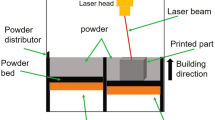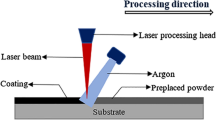Abstract
DC53 tool steel has potential applications in mold product manufacturing because of its excellent toughness properties. However, it suffers from poor wear resistance, which limits its wide range of applications. A micron-size fish-scale film structure was designed on the DC53 steel surface and fabricated using crossover laser surface remelting processing to improve its tribological properties. Three kinds of DC53 surfaces, including the as-received, quenched, and fish-scale film structure, were used to evaluate the tribological properties. Specifically, tribological performance was evaluated using a reciprocating sliding tester. The unidirectional ball-on-disc method was employed to assess the wear of the mating surfaces under low-, medium-, and high-load conditions in terms of friction and wear tests. The friction coefficient and the wear rate were recorded to investigate the formation mechanism of tribo-layers. Experimental results demonstrated that the structure combined with microbulges on the DC53 surface had excellent load-bearing capabilities and wear resistance. Energy dispersive spectroscopy following wear tests showed pronounced material transfer from the structured surfaces, with SiO2 particles filling up some groove voids. The reinforcing layer in the form of nanoscale SiO2 particles exhibited enhanced performance at higher tribological loads. The synergistic effects of microbulges and SiO2 films significantly improved the tribological properties of DC53 materials. In addition, the precipitation of SiO2 contributed to the anti-wear performance of the tool steel surface, which is consistent with the self-lubricating wear mechanism of the worn surface. The laser surface remelting technique enables the fabrication of a micro fish-scale film structure, which has great potential for enhancing the wear resistance and applications of DC53 materials in various fields.













Similar content being viewed by others
Data availability
All data generated or analyzed during this study are included in this published article.
References
Kanlayasiri, K., & Boonmung, S. (2007). Effects of wire-EDM machining variables on surface roughness of newly developed DC 53 die steel: Design of experiments and regression model. Journal of Materials Processing Technology, 192, 459–464. https://doi.org/10.1016/j.jmatprotec.2007.04.085
Rehman, M., Khan, S. A., & Naveed, R. (2020). Parametric optimization in wire electric discharge machining of DC53 steel using gamma phase coated wire. Journal of Mechanical Science and Technology, 34(7), 2767–2773. https://doi.org/10.1007/s12206-020-0609-2
Kanlayasiri, K., & Boonmung, S. (2007). An investigation on effects of wire-EDM machining parameters on surface roughness of newly developed DC53 die steel. Journal of Materials Processing Technology, 187, 26–29. https://doi.org/10.1016/j.jmatprotec.2006.11.220
Kanlayasiri, K., Jattakul, P., & Mookam, N. (2022). Machinability of tool steels machined by electric-discharge machining. Creative Science, 14(1), 25–31. https://doi.org/10.55674/snrujst.v14i1.244172
Mao, D., Wang, X., Wang, W., & Wei, X. (2012). Effect of boronizing on the dry sliding wear behavior of DC53/0.45 mass% C steel pairs. Surface and Coatings Technology, 207, 190–195. https://doi.org/10.1016/j.surfcoat.2012.06.061
Wen, D.-C. (2010). Erosion and wear behavior of nitrocarburized DC53 tool steel. Wear, 268(3–4), 629–636. https://doi.org/10.1016/j.wear.2009.10.012
Hassan, S., Khan, S. A., Naveed, R., Saleem, M. Q., Mufti, N. A., & Farooq, M. U. (2023). Investigation on tool wear mechanisms and machining tribology of hardened DC53 steel through modified CBN tooling geometry in hard turning. The International Journal of Advanced Manufacturing Technology, 127, 547–564. https://doi.org/10.1007/s00170-023-11528-5
Aramaki, M., Yamada, N., & Furukimi, O. (2011). Effect of combined shot treatment and nitriding on galling property of die used for high strength steels. ISIJ international, 51(7), 1137–1141. https://doi.org/10.2355/isijinternational.51.1137
Wang, W., Zheng, X., Hua, M., & Wei, X. (2016). Influence of surface modification on galling resistance of DC53 tool steel against galvanized advanced high strength steel sheet. Wear, 360–361, 1–13. https://doi.org/10.1016/j.wear.2016.04.021
Cora, Ö. N., Ağcayazı, A., Namiki, K., Sofuoğlu, H., & Koç, M. (2012). Die wear in stamping of advanced high strength steels – Investigations on the effects of substrate material and hard-coatings. Tribology international, 52, 50–60. https://doi.org/10.1016/j.triboint.2012.02.016
Kim, J., Chun, D.-M., Park, H. W., & Kim, J. (2023). Waterproof and Wear-Resistant Surface Treatment on Printed Parts of Polyamide 12 (PA12) by Selective Laser Sintering Using a Large Pulsed Electron Beam. International Journal of Precision Engineering and Manufacturing-Green Technology, 10(1), 71–83. https://doi.org/10.1007/s40684-022-00420-4
Li, L., Li, Z., Xing, Z., Guo, W., Huang, Y., & Wang, H. (2023). Effect of femtosecond laser bionic texture on anti-wear properties of medical Ti-6Al-4 V. Tribology international, 190, 109062. https://doi.org/10.1016/j.triboint.2023.109062
Xing, Y., Deng, J., Wu, Z., & Wu, F. (2017). High friction and low wear properties of laser-textured ceramic surface under dry friction. Optics & Laser Technology, 93, 24–32. https://doi.org/10.1016/j.optlastec.2017.01.032
Lian, Z., Cheng, Y., Xu, J., Xu, J., Ren, W., Tian, Y., & Yu, H. (2023). Green fabrication of anti-friction slippery liquid-infused metallic surface with sub-millimeter-scale asymmetric bump arrays and its application. International Journal of Precision Engineering and Manufacturing-Green Technology, 10(5), 1281–1298. https://doi.org/10.1007/s40684-022-00463-7
Guo, Z., Guo, B., Zhao, Q., Zeng, Z., & Xu, L. (2023). Wear characteristics of micro-structured CVD diamond grinding tools. Wear, 514–515, 204569. https://doi.org/10.1016/j.wear.2022.204569
Dai, F. Z., Geng, J., Tan, W. S., Ren, X. D., Lu, J. Z., & Huang, S. (2018). Friction and wear on laser textured Ti6Al4V surface subjected to laser shock peening with contacting foil. Optics & Laser Technology, 103, 142–150. https://doi.org/10.1016/j.optlastec.2017.12.044
Li, X., Deng, J., Lu, Y., Duan, R., & Ge, D. (2022). Machinability investigation and sustainability assessment of dry cutting AISI1045 steel using tools configured with shark-skin-inspired structures and WS2/C coatings. International Journal of Precision Engineering and Manufacturing-Green Technology, 9(1), 83–106. https://doi.org/10.1007/s40684-021-00330-x
Qiu, Y., Liu, W., Jin, L., Ye, Z., Chen, J., & Wang, Y. (2023). Picosecond laser-textured WC-10Co4Cr metal-ceramic composite coatings with high wear resistance property. Surface and Coatings Technology, 474, 130073. https://doi.org/10.1016/j.surfcoat.2023.130073
Liu, X., Guo, Z., Lu, Z., & Qin, L. (2023). Tribological behavior of the wear-resistant and self-lubrication integrated interface structure with ordered micro-pits. Surface and Coatings Technology, 454, 129159. https://doi.org/10.1016/j.surfcoat.2022.129159
Lu, L., Zhang, Z., Guan, Y., & Zheng, H. (2018). Comparison of the effect of typical patterns on friction and wear properties of chromium alloy prepared by laser surface texturing. Optics & Laser Technology, 106, 272–279. https://doi.org/10.1016/j.optlastec.2018.04.020
Jia, X., Zhang, Y., Dong, X., & Wang, Z. (2024). Enhanced lipophilicity and wear resistance of 20CrMnTi induced by laser surface texturing. Optics & Laser Technology, 170, 110329. https://doi.org/10.1016/j.optlastec.2023.110329
Wang, W., Yuan, W., Guo, Q., Wang, N., Chi, B., & Yu, J. (2024). Effect of picosecond laser surface texturing under Babbitt coating mask on friction and wear properties of GCr15 bearing steel surface. Engineering Failure Analysis, 157, 107878. https://doi.org/10.1016/j.engfailanal.2023.107878
Lu, G., Sokol, D. W., Zhang, Y., & Dulaney, J. L. (2019). Nanosecond pulsed laser-generated stress effect inducing macro-micro-nano structures and surface topography evolution. Applied Materials Today, 15, 171–184. https://doi.org/10.1016/j.apmt.2019.01.005
Pan, X., Zhou, L., Hu, D., He, W., Liu, P., Yu, Z., & Liang, X. (2023). Superior wear resistance in cast aluminum alloy via femtosecond laser induced periodic surface structures and surface hardening layer. Applied Surface Science, 636, 157866. https://doi.org/10.1016/j.apsusc.2023.157866
Pfefferkorn, F. E., & Morrow, J. D. (2017). Controlling surface topography using pulsed laser micro structuring. CIRP Annals, 66(1), 241–244. https://doi.org/10.1016/j.cirp.2017.04.138
Temmler, A., Willenborg, E., & Wissenbach, K. (2011). Design surfaces by laser remelting. Physics Procedia, 12, 419–430. https://doi.org/10.1016/j.phpro.2011.03.053
Bordatchev, E. V., Küpper, M., Cvijanovic, S. J., Willenborg, E., Milliken, N., Temmler, A., & Tutunea-Fatan, O. R. (2020). Edge-lit sine-shape wedged light guides: Design, optical simulation, laser-remelting-based precision fabrication, and optical performance evaluation. Precision Engineering, 66, 333–346. https://doi.org/10.1016/j.precisioneng.2020.07.004
Temmler, A., & Pirch, N. (2020). Investigation on the mechanism of surface structure formation during laser remelting with modulated laser power on tool steel H11. Applied Surface Science, 526, 146393. https://doi.org/10.1016/j.apsusc.2020.146393
Temmler, A., Pirch, N., Luo, J., Schleifenbaum, J. H., & Häfner, C. L. (2020). Numerical and experimental investigation on formation of surface structures in laser remelting for additive-manufactured Inconel 718. Surface and Coatings Technology, 403, 126370. https://doi.org/10.1016/j.surfcoat.2020.126370
Temmler, A., Dai, W., Schmickler, T., Küpper, M. E., & Häfner, C. L. (2021). Experimental investigation on surface structuring by laser remelting (WaveShape) on Inconel 718 using varying laser beam diameters and scan speeds. Applied Surface Science, 541, 147814. https://doi.org/10.1016/j.apsusc.2020.147814
Kreinest, L., Schober, B., Willenborg, E., & Stollenwerk, J. (2024). Investigation of asymmetry reduction for surface structuring and destructuring by laser remelting. Heliyon, 10(2), e24067. https://doi.org/10.1016/j.heliyon.2024.e24067
Dai, W., Zhang, W., Zheng, Z., & Li, J. (2019). Investigation of micron-sized fish-scale surface structures on tool steel surfaces using laser galvanometer scanning. Applied Surface Science, 470, 1111–1121. https://doi.org/10.1016/j.apsusc.2018.10.264
Graat, P. C. J., & Somers, M. A. J. (1996). Simultaneous determination of composition and thickness of thin iron-oxide films from XPS Fe 2p spectra. Applied Surface Science, 100, 36–40. https://doi.org/10.1016/0169-4332(96)00252-8
Alfonsetti, R., Lozzi, L., Passacantando, M., Picozzi, P., & Santucci, S. (1993). XPS studies on SiOx thin films. Applied Surface Science, 70, 222–225. https://doi.org/10.1016/0169-4332(93)90431-A
Alfonsetti, R., De Simone, G., Lozzi, L., Passacantando, M., Picozzi, P., & Santucci, S. (1994). SiOx surface stoichiometry by XPS: A comparison of various methods. Surface and interface analysis, 22(1–12), 89–92. https://doi.org/10.1002/sia.740220122
Acknowledgements
We would like to express our deep gratitude to the IPG Photonics Corporation for their cooperation and support in fabricating the structures studied in this work. We also thank the Analysis and Test Center of Huazhong University of Science and Technology), for their testing service. This work was funded by the Chinese National Science and Technology Major Project (Item No. 2018YFB1106), and the key laboratory fund project of Hubei Key Laboratory of Digital Textile Equipment, Wuhan Textile University (Grant No. DTL2023015, KDTL2023006).
Author information
Authors and Affiliations
Corresponding authors
Ethics declarations
Conflict of Interest
The authors declare that they have no known competing financial interests or personal relationships that could have appeared to influence the work reported in this paper.
Additional information
Publisher's Note
Springer Nature remains neutral with regard to jurisdictional claims in published maps and institutional affiliations.
Rights and permissions
Springer Nature or its licensor (e.g. a society or other partner) holds exclusive rights to this article under a publishing agreement with the author(s) or other rightsholder(s); author self-archiving of the accepted manuscript version of this article is solely governed by the terms of such publishing agreement and applicable law.
About this article
Cite this article
Dai, W., Fang, C., Wu, X. et al. Enhanced Wear Properties of an Inspired Fish-Scale Film Structure in Terms of Microstructured Self-Lubrication Induced Effects by High-Speed Laser Surface Remelting Processing. Int. J. of Precis. Eng. and Manuf.-Green Tech. (2024). https://doi.org/10.1007/s40684-024-00610-2
Received:
Revised:
Accepted:
Published:
DOI: https://doi.org/10.1007/s40684-024-00610-2




